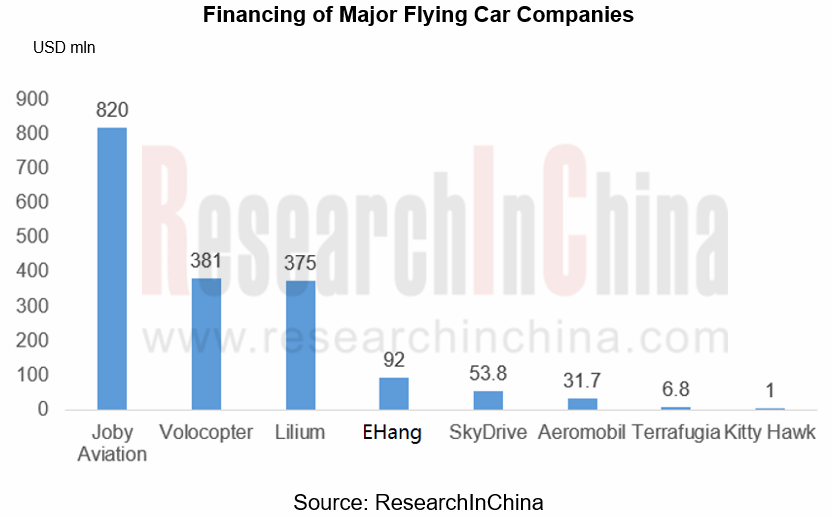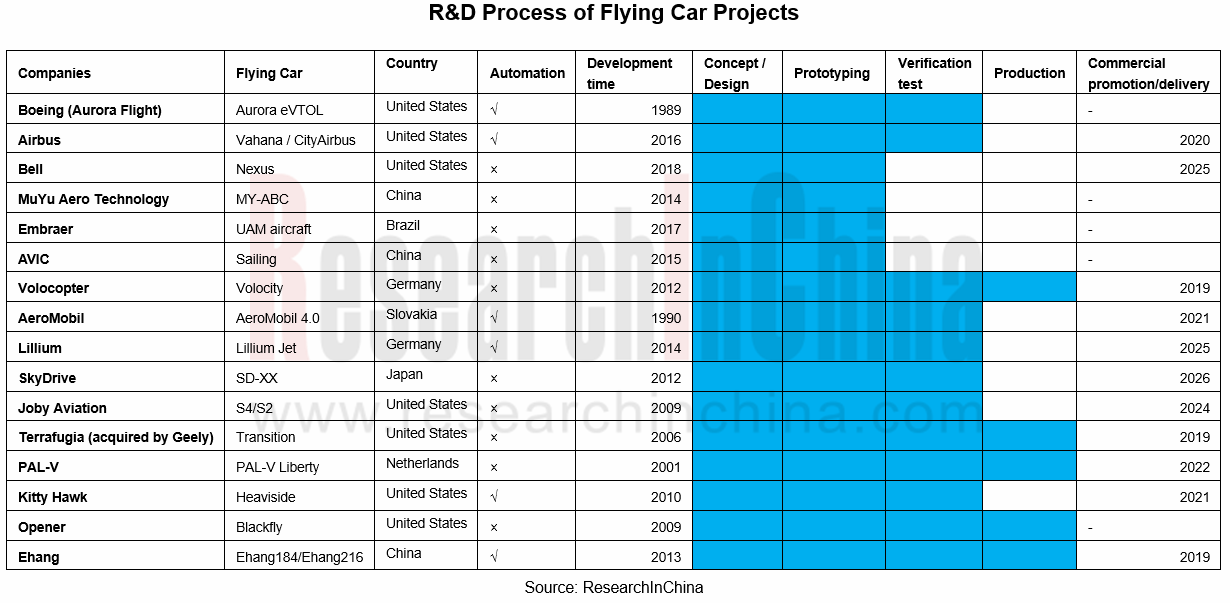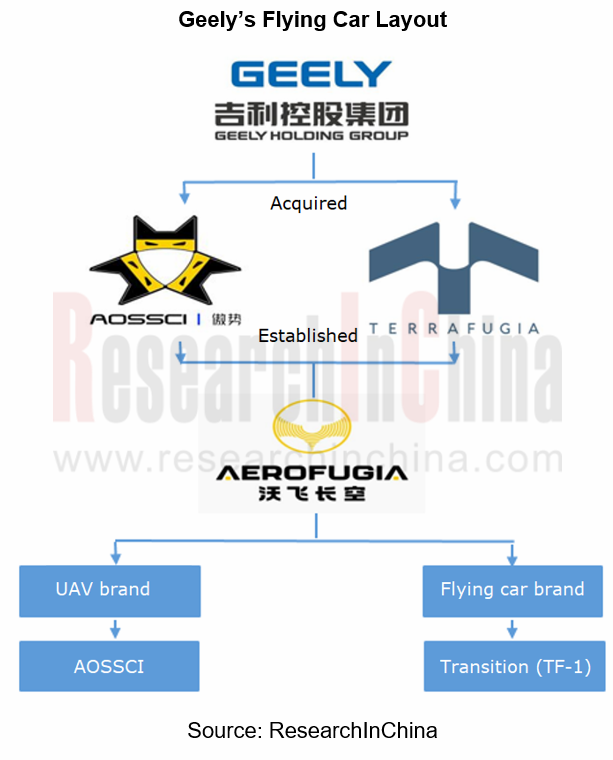Flying Car Research: The prospect is promising. Creator of Google self-driving cars turns to track of flying cars
ResearchInChina released Global and China Flying Car Industry Report, 2020-2026, analyzing eVTOL ((Electric Vertical Takeoff and Landing) from the perspective of status quo, trends, business models, financing, the layout of major players, and product solutions.
Compared with traditional cars and aircrafts, eVTOL has gradually materialized, featuring zero emission, low cost, point-to-point low-altitude flight (short mobility time without geographical restrictions), vertical take-off and landing, land and aerial applications. For example, EHang 216 with multi-rotor electric vertical take-off and landing is used as an ambulance in the coronavirus crisis.
Investors favor urban air mobility (UAM). The total financing of the three unicorns exceeds USD1.5 billion
By 2030, 60% of the population will migrate into cities, which may pose enormous pressure on urban ground transportation. By then, the demand for urban aerial short-distance mobility will increase significantly. Morgan Stanley predicts that the flying car market will reach USD320 billion by 2030.
Flying cars have been favored by many investors due to the broad application prospects. Larry Page, cofounder and CEO of Alphabet, Google’s parent company, was among the first to recognize their potentials, personally funding three companies, Zee Aero, Opener and Kitty Hawk. Particularly, Sebastian Thrun, Google's self-driving team founder turned CEO of flying vehicle startup Kitty Hawk. This indicates the trend of the mobility market: the future transportation may develop in the sky.
Among the three flying car unicorns, Joby Aviation is from the United States, Volocopter and Lilium are from Germany. Joby Aviation has raised the overwhelming USD820 million. Volocopter has announced the signing of their Series D funding round, and its investors include Geely, Daimler, Geely, Daimler, DB Schenker, Intel Capital, etc.

Currently, 5 flying car models have been mass-produced. Electrification and autonomous driving are the mainstream
American companies (accounting for nearly 50%) are the most enthusiastic about developing flying cars, followed by Chinese companies. Many companies aim to materialize flying cars around 2025. Five flying car projects have seen mass production, and 38% have realized automation.
Automotive technology and aviation technology are merging with each other. Benefiting from the development of automotive electrification, flying cars have a progress in endurance. For example, Airbus Vahana eVTOL has a range of up to 50 kilometers, which basically enables urban short-distance mobility.

Amid many participants, Geely, Xpeng, Hyundai and other OEMs have deployed the market
Currently, traditional airlines such as Boeing, Airbus, Bell, etc. have embarked on flying car projects. Technology companies follow suit. For example, Uber has established Uber Elevate to develop flying taxis with 9 partners including Embraer, Aurora Flight Sciences, Jaunt Air Mobility, etc.
The CEO of the OEM Xpeng recently stated that it will build flying cars in 2021. Geely completed its acquisition of the US flying-car startup Terrafugia, and invested in Volocopter, a German electric flying taxi R&D company, demonstrating its ambition to deploy UAM. Recently, Transition (TF-1), a subsidiary of Geely, obtained the world's first special airworthiness certificate from the Federal Aviation Administration (FAA), USA.

The United States, Germany, China, South Korea, Japan and many other countries have paid attention to the concept of flying cars, and many of them have formulated UAM development plans. Affected by favorable policies, insufficient urban road traffic space, autonomous driving and the development of 5G communication technology, flying cars are expected to become an important way of smart mobility in the future.
OEMs and Tier 1 Suppliers' Cost Reduction and Efficiency Enhancement Strategy Analysis Report, 2025
ResearchInChina released the "OEMs and Tier 1 Suppliers' Cost Reduction and Efficiency Enhancement Strategy Analysis Report, 2025", summarizing hundreds of cost reduction strategies to provide referen...
Automotive Fixed Panoramic Sunroof and Smart Roof Research Report, 2025
With the intelligent application of car roofs as the core, this report systematically sorts out a series of new products such as fixed panoramic sunroof/openable sunroof, ceiling screen, roof ambient ...
Automotive-Grade Power Semiconductor and Module (SiC, GaN) Industry Research Report, 2025
SiC/GaN Research: Sales volume of 800V+ architecture-based vehicles will increase more than 10 times, and hybrid carbon (SiC+IGBT) power modules are rapidly being deployed in vehicles.
Sales volume o...
Cockpit Agent Engineering Research Report, 2025
Cockpit Agent Engineering Research: Breakthrough from Digital AI to Physical AI
Cockpit Agent Engineering Research Report, 2025 starts with the status quo of cockpit agents, summarizes the technical ...
Prospective Study on L3 Intelligent Driving Technology of OEMs and Tier 1 Suppliers, 2025
L3 Research: The Window of Opportunity Has Arrived - Eight Trends in L3 Layout of OEMs and Tier 1 Suppliers
Through in-depth research on 15 OEMs (including 8 Chinese and 7 foreign OEMs) and 9 Tier 1 ...
China Commercial Vehicle IoV and Intelligent Cockpit Industry Research Report 2025
Commercial Vehicle IoV and Cockpit Research: The Third Wave of Passenger Car/Commercial Vehicle Technology Integration Arrives, and T-Box Integrates e-Call and 15.6-inch for Vehicles
I. The third wav...
Intelligent Vehicle Electronic and Electrical Architecture (EEA) and Technology Supply Chain Construction Strategy Research Report, 2025
E/E Architecture Research: 24 OEMs Deploy Innovative Products from Platform Architectures to Technical Selling Points
According to statistics from ResearchInChina, 802,000 passenger cars with domain...
Research Report on Intelligent Vehicle Cross-Domain Integration Strategies and Innovative Function Scenarios, 2025
Cross-Domain Integration Strategy Research: Automakers' Competition Extends to Cross-Domain Innovative Function Scenarios such as Cockpit-Driving, Powertrain, and Chassis
Cross-domain integration of ...
China Autonomous Driving Data Closed Loop Research Report, 2025
Data Closed-Loop Research: Synthetic Data Accounts for Over 50%, Full-process Automated Toolchain Gradually Implemented
Key Points:From 2023 to 2025, the proportion of synthetic data increased from 2...
Automotive Glass and Smart Glass Research Report, 2025
Automotive Glass Report: Dimmable Glass Offers Active Mode, Penetration Rate Expected to Reach 10% by 2030
ResearchInChina releases the Automotive Glass and Smart Glass Research Report, 2025. This r...
Passenger Car Brake-by-Wire (BBW) Research Report, 2025
Brake-by-Wire: EHB to Be Installed in 12 Million Vehicles in 2025
1. EHB Have Been Installed in over 10 Million Vehicles, A Figure to Hit 12 Million in 2025.
In 2024, the brake-by-wire, Electro-Hydr...
Autonomous Driving Domain Controller and Central Computing Unit (CCU) Industry Report, 2025
Research on Autonomous Driving Domain Controllers: Monthly Penetration Rate Exceeded 30% for the First Time, and 700T+ Ultrahigh-compute Domain Controller Products Are Rapidly Installed in Vehicles
L...
China Automotive Lighting and Ambient Lighting System Research Report, 2025
Automotive Lighting System Research: In 2025H1, Autonomous Driving System (ADS) Marker Lamps Saw an 11-Fold Year-on-Year Growth and the Installation Rate of Automotive LED Lighting Approached 90...
Ecological Domain and Automotive Hardware Expansion Research Report, 2025
ResearchInChina has released the Ecological Domain and Automotive Hardware Expansion Research Report, 2025, which delves into the application of various automotive extended hardware, supplier ecologic...
Automotive Seating Innovation Technology Trend Research Report, 2025
Automotive Seating Research: With Popularization of Comfort Functions, How to Properly "Stack Functions" for Seating?
This report studies the status quo of seating technologies and functions in aspe...
Research Report on Chinese Suppliers’ Overseas Layout of Intelligent Driving, 2025
Research on Overseas Layout of Intelligent Driving: There Are Multiple Challenges in Overseas Layout, and Light-Asset Cooperation with Foreign Suppliers Emerges as the Optimal Solution at Present
20...
High-Voltage Power Supply in New Energy Vehicle (BMS, BDU, Relay, Integrated Battery Box) Research Report, 2025
The high-voltage power supply system is a core component of new energy vehicles. The battery pack serves as the central energy source, with the capacity of power battery affecting the vehicle's range,...
Automotive Radio Frequency System-on-Chip (RF SoC) and Module Research Report, 2025
Automotive RF SoC Research: The Pace of Introducing "Nerve Endings" such as UWB, NTN Satellite Communication, NearLink, and WIFI into Intelligent Vehicles Quickens
RF SoC (Radio Frequency Syst...